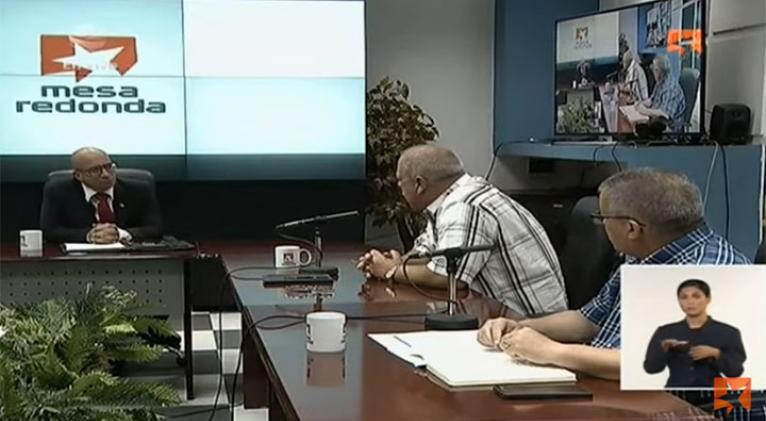 Guantanamo.- At Mesa Redonda broadcast, Minister of Energy and Mines (Minem) Vicente de la O Levy appeared, on Thursday, Sept. 11th, to update the population on the recovery of the National Electric System (SEN). He explained that the causes behind the shutdown of the Antonio Guiteras Thermoelectric Power Plant (CTE) are still under investigation.
Guantanamo.- At Mesa Redonda broadcast, Minister of Energy and Mines (Minem) Vicente de la O Levy appeared, on Thursday, Sept. 11th, to update the population on the recovery of the National Electric System (SEN). He explained that the causes behind the shutdown of the Antonio Guiteras Thermoelectric Power Plant (CTE) are still under investigation.
The minister emphasized and expressed gratitude for the continuous support of all government bodies and territorial entities, as well as the tireless work of electrical workers, which played a decisive role in the swift recovery of the SEN.
Engineer Lázaro Guerra, Director of Electricity at Minem, stressed that rigorous protocols exist for the restoration of the SEN, enabling its reestablishment in the shortest possible time.
“Each time a disconnection occurs, the conditions are not exactly the same,” he noted, explaining that the available units and networks vary. “That is why the first step after a system collapse is a thorough evaluation.”
As a strength in this instance, Guerra highlighted that no thermoelectric plant was affected.
He explained that the first directive following an evaluation is to activate microsystems, since distributed generation makes it possible to supply power to vital centers and, in turn, channel electricity to large thermoelectric plants.
By 7:36 a.m., the SEN was already reconnected, and by 1:00 p.m., all provinces in the country had electricity restored, he pointed out.
Alfredo López Valdés, Director General of the Electric Union, underscored that in his view, two root causes led to the incident: the lack of maintenance on the Guiteras plant this year, and the insufficient regulation currently present in the SEN.
He announced that a major overhaul of the Guiteras facility is scheduled for the end of the year and will extend over six months.
Among the planned tasks are replacement of the boiler reheater —one of the main causes of recent shutdowns— as well as replacement of regenerative heaters, burners, air and gas ducts, economizer tubing, and a chemical cleaning of the boiler to safeguard it after modifications. The overhaul will also include capital maintenance on the high-pressure cylinder of the turbine.
To address low regulation in the SEN, López Valdés revealed that work is underway to acquire four battery energy storage systems that will help stabilize the grid.
“This is a new technology, each unit with a capacity of 50 megawatts (MW) of power and 50 MW of storage, for a total of 200 MW. Had we had these in operation, this SEN disconnection would not have happened,” he explained.
Although progress is being made on addressing root causes, López Valdés admitted, “It is not at the pace we would like.”
He also highlighted that this year, maintenance has been carried out on five turbines, something unprecedented in the same period in previous years.
Regarding the Felton power plant, López Valdés reported that work continues uninterrupted. Unit 2 will still take at least two more years, while Unit 1 is undergoing a 20-day maintenance cycle as an existing malfunction is being evaluated.
During the program, Minister De la O Levy informed viewers that the Guiteras plant had once again gone offline but was already in the startup process before the broadcast concluded.
“These are normal processes, although frustrating for the population. They occur because of reduced reserves, which leave the system in a very fragile state,” he emphasized.
On the government’s strategy to improve the situation, De la O Levy clarified that it is “much broader than just photovoltaic solar parks.”
He pointed out that reduced fuel production is one of the main causes of the current difficulties, making recovery in this sector a top priority.
Maintenance work on oil well infrastructure, along with the necessary supplies, has already yielded a slight increase in production compared to the previous year.
At the same time, part of the strategy focuses on reducing fuel consumption, which is where solar power plays a key role. With more than 30 solar parks inaugurated and synchronized, these facilities are already contributing over 600 MW.
“We do not have sufficient fuel, and we must achieve independence from fuel imports,” he stressed. “Photovoltaic solar power is the renewable energy source that can be deployed the fastest, has high efficiency levels, and allows for multiple projects to be built simultaneously.”
To this program, the minister added, energy storage systems will also be integrated to strengthen grid stability.